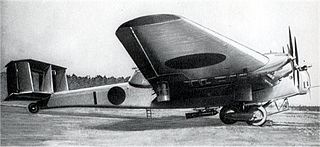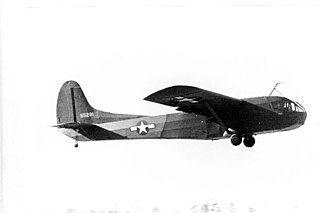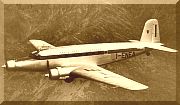
Canvas is an extremely durable plain-woven fabric used for making sails, tents, marquees, backpacks, shelters, as a support for oil painting and for other items for which sturdiness is required, as well as in such fashion objects as handbags, electronic device cases, and shoes. It is popularly used by artists as a painting surface, typically stretched across a wooden frame.

The Zivko Edge 540 manufactured by Zivko Aeronautics is a highly aerobatic aircraft. Capable of a 420 degree per second roll rate and a 3,700 foot per minute climb rate, it has been flown to victory on the international Unlimited aerobatics circuit several times since the mid-1990s. A tandem-seat version is sold as the Edge 540T.

The Mitsubishi Ki-20 is a Japanese bomber variant of the Junkers G.38 airliner. Mitsubishi manufactured six aircraft under license from Junkers. These aircraft, designated Army Type 92 Heavy Bomber, served through the 1930s. During World War II, the Ki-20 served in a variety of transport and support roles.

The IBM 6400 Accounting Machine is a series of four calculating and accounting machines produced by the IBM Electric Typewriter (ET) division in 1962. It was announced in January 1963 and was sold to perform what IBM referred to as BICARSA, which stood for billing, inventory control, accounts receivable and sales analysis.

Kraft paper or kraft is paper or paperboard (cardboard) produced from chemical pulp produced in the kraft process.
Grammage and basis weight, in the pulp and paper industry, are the area density of a paper product, that is, its mass per unit of area. Two ways of expressing grammage are commonly used:
The Messerschmitt Me 265 was a design project for a Zerstörer, produced by leading German aircraft manufacturer Messerschmitt in World War II.

The Waco CG-15 was an American military glider, which was developed from the CG-4. Although outwardly similar to its predecessor and carrying the same number of passengers, a number of changes in the design, including shortened wings and a more streamlined nose enabled it to travel faster. 1,000 were ordered and 473 were delivered before production ceased. Two were transferred to the Navy for testing as the XLR2W-1. One unit was converted into an XPG-3 powered glider which used two Jacobs R-755-9 radial engines.
The Roe II Triplane, sometimes known as the Mercury, was an early British aircraft and the first product of the Avro company. It was designed by Alliott Verdon Roe as a sturdier development of his wood-and-paper Roe I Triplane. Two examples were built, one as a display machine for Roe's new firm, and the second was sold to W. G. Windham. The longest recorded flight made by the Roe II Triplane was 600 ft (180 m).

The Bristol Boarhound was a British army cooperation and liaison aircraft of the 1920s. It was a two-seat biplane with wings of equal span and a steel frame construction with fabric covering.

The Fiat G.212 was an Italian three-engine airliner of the 1940s. An enlarged development of Fiat's earlier G.12 transport, it was used in small numbers in commercial service and by the Italian Air Force.

Paper is a thin sheet material produced by mechanically or chemically processing cellulose fibres derived from wood, rags, grasses, or other vegetable sources in water, draining the water through a fine mesh leaving the fibre evenly distributed on the surface, followed by pressing and drying. Although paper was originally made in single sheets by hand, almost all is now made on large machines—some making reels 10 metres wide, running at 2,000 metres per minute and up to 600,000 tonnes a year. It is a versatile material with many uses, including printing, painting, graphics, signage, design, packaging, decorating, writing, and cleaning. It may also be used as filter paper, wallpaper, book endpaper, conservation paper, laminated worktops, toilet tissue, currency, and security paper, or in a number of industrial and construction processes.
The Akaflieg Stuttgart F-1 Fledermaus (Bat) was a glider designed and built in Germany from 1932.
Akaflieg Darmstadt is one of approximately twenty aviation groups attached to German universities. Akaflieg is an abbreviation for Akademische Fliegergruppe, an academic group of students and faculty from a German University.

The Horten H.III was a flying wing sailplane built by Walter and Reimar Horten in Germany from 1937 to 1944.

The Gotha Go 150 was a light aircraft designed at the German company Gothaer Waggonfabrik in the late 1930s. It was intended for civilian use, but ended up being used as a military trainer.
The Antonov T-2M Maverick is a Ukrainian ultralight trike, designed and produced by Antonov.
The La Mouette Skybike is a line of French paramotors that was designed and produced by La Mouette of Fontaine-lès-Dijon for powered paragliding.

The Brutsche Freedom 40 was an American homebuilt aircraft that was designed by Neal H. Brutsche and produced by Brutsche Aircraft Corporation of Salt Lake City, Utah. The aircraft was intended to be supplied in the form of plans for amateur construction, with a partial kit available.
The Hinz BLT-ARA is a German homebuilt aircraft that was designed and produced by L and B Hinz of Filderstadt. When it was available the aircraft was supplied as in the form of plans and a 300-page builder's manual for amateur construction.











